In the rapidly changing and evolving business landscape, diversity in the workplace has emerged and been identified as a key driver of success and innovation. Beyond being a mere buzzword, diversity brings a multitude of benefits that impact both the bottom line and the overall health of an organization.
In this article, I will take a comprehensive look at the business case for workplace diversity and explore why it’s more than just a feel-good initiative.
1. Driving Innovation

Research shows that diverse and inclusive organizations, when compared to their peers, are: 87% more likely to make better decisions, according to Korn Ferry Research. 75% faster at bringing products to market, according to the Center for Talent Innovation.
Diverse teams fuel innovation. When individuals from different backgrounds, experiences, and perspectives collaborate, they bring a rich tapestry of ideas to the table. In essence, diverse teams have a competitive edge and advantage to your organization.
2. Expanding Market Reach
Diverse Companies Earn 2.5 Times Higher Cash Flow Per Employee and Inclusive Teams Are More Productive by Over 35% according to an article at Global Newswire.
In our globalized world, diversity mirrors the reality of diverse consumer populations. A workforce that represents various demographics can better understand the needs and preferences of a broader customer base. Your organization with a diverse talent pool can be more adept at tailoring your products and marketing strategies to effectively engage with diverse communities, thus expanding your market share and enhance customer loyalty.
3. Enhancing Problem-Solving
When diverse teams are managed by skilled inclusive leaders, they may be outperformed by homogenous teams in the early stages of working together because disruption and conflict can result when different perspectives, experiences, backgrounds, thinking, and communication styles are brought into a team.
4. Boosting Employee Engagement
Inclusive leaders in inclusive workplaces foster a sense of belonging and value among employees. When individuals feel respected and accepted for who they are, they’re more likely to be engaged, motivated, and committed to their work.
This heightened engagement translates into increased productivity and reduced turnover rates, saving companies the costs associated with recruitment and training.
5. Enhancing Reputation
When your organization decide to prioritize diversity and inclusion, you cultivate a positive reputation. In today’s socially conscious world, consumers and potential employees are drawn to organizations that embrace diversity. By actively promoting diversity, your organization would attract top talent and build strong relationships with customers who align with your values.
6. Mitigating Risks
A lack of diversity lead to stagnation and groupthink, inhibiting an organization’s ability to adapt to changing markets and trends. By embracing diversity, companies can mitigate these risks by tapping into a range of perspectives that ensure a more resilient and flexible business approach.
In conclusion, the business case for workplace diversity is undeniable. It’s not just about fairness and equality; it’s about driving business growth and resilience. Diverse teams foster innovation, expand market reach, enhance problem-solving, boost employee engagement, and ultimately enhance a company’s reputation. As the business landscape becomes increasingly interconnected and multicultural, organizations that fail to embrace diversity risk falling behind.
You can reach out to me to discuss how your organization can be more inclusive.
